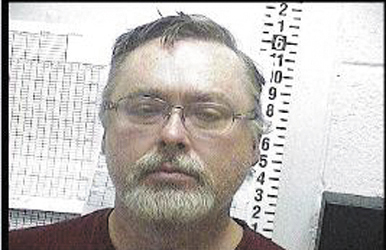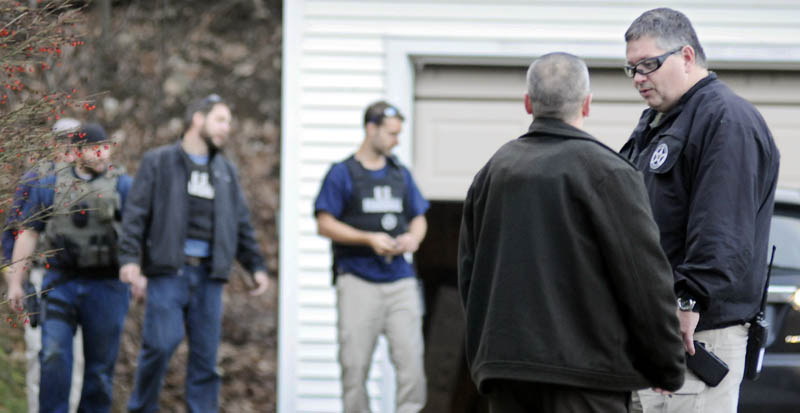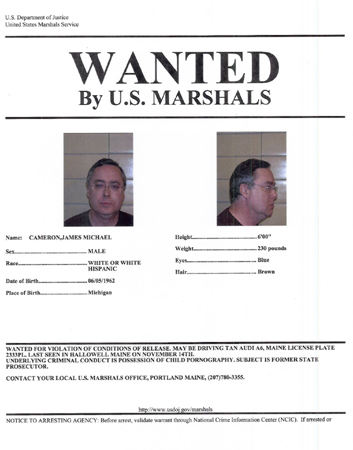More than two weeks ago, Maine’s former top drug prosecutor cut off the electronic monitoring bracelet that had tracked his whereabouts for 14 months, got into his tan-colored 1999 Audi A6 and drove more than 2,000 miles to Albuquerque, N.M.
That’s where the nationwide manhunt for 50-year-old James Cameron ended Sunday morning, when federal marshals arrested him as he emerged from a bathroom at a store that specializes in the sale of books, movies, videos and video games.
U.S. marshals, who had placed the Hastings Store under surveillance, said Cameron surrendered peacefully about 11:15 a.m. He was not armed.
Cameron had been convicted of possession of child pornography in Maine. He was sentenced to more than 16 years in prison, but had been out on bail for more than a year pending an appeal. He was scheduled to return to prison.
But what led him to drive from his camp in Rome to an entertainment store in New Mexico remained a mystery Sunday night.
Federal officials clamped down on releasing any further information until an investigation into his escape by the U.S. Attorney’s Office for Maine is completed.
One possibility is that the U.S. Attorney’s Office might be looking into whether anyone assisted Cameron in his flight from federal authorities. An arrest warrant for Cameron was issued Nov. 15, which means he enjoyed 17 days of freedom.
“He wasn’t free for all that long, especially for the effort he invested in this,” U.S. Marshal Noel March said in a telephone interview Sunday night. “We worked around the clock, every day, for seven days a week. It took a tremendous amount of effort and staff resources to apprehend Mr. Cameron.”
March said he could not say how Cameron financed his cross-country trip, if he had a visa, or where he was headed. Albuquerque is about 200 miles from the U.S. border with Mexico.
March did confirm that Cameron at some point changed license plates on his 1999 Audi, which he drove to New Mexico.
“U.S. marshals in Maine developed information that Cameron was in New Mexico and contacted the U.S. marshals there. Deputies in New Mexico conducted surveillance and shortly after apprehended Mr. Cameron. Cameron was exiting a Hastings Store bathroom and surrendered to U.S. marshals without incident,” March said in a prepared statement.
Cameron was being held Sunday night at the Sandoval County Detention Center in Rio Rancho, N.M., where he was charged with violating the conditions of his release.
Intake workers at the New Mexico jail said Sunday night they are not told in advance when a federal prisoner will appear in court. Jail workers said Cameron is not eligible for bail.
Donald E. Clark, a spokesman for the U.S. Attorney’s Office in Maine, said Cameron won’t be returning to Maine anytime soon.
“He definitely won’t be returning Monday. It could take a while to initiate the (court) proceedings in New Mexico,” Clark said.
Typically, a fugitive charged with a state offense is extradited after being captured outside Maine. Clark said he was not certain if the same extradition rules will apply to a federal prisoner like Cameron.
Clark said the investigation into Cameron’s escape could result in additional charges against him.
According to federal investigators, Cameron had been living at his camp in Rome when he decided to flee. They say that other than his car and laptop, he took little else with him.
Cameron fled a day after a federal appeals court in Boston upheld seven of the 13 counts he was found guilty of in his 2010 child pornography trial. Wearing an electronic monitoring device was a condition of his release.
Cameron is a former chief drug crimes prosecutor in the Maine Office of the Attorney General, where he spent 18 years as an assistant attorney general.
He became the target of an investigation after the National Center for Missing and Exploited Children reported that Yahoo had found multiple images of child pornography in a Yahoo account belonging to Cameron’s wife.
He was fired in April 2008 and indicted on child pornography charges in February 2009. He was convicted of 13 charges on Aug. 23, 2010, after a six-day non-jury trial.
Cameron and his ex-wife, Barbara, married when he was 22. They had two children, a boy and a girl, and owned a home in Hallowell as well as the camp in Rome.
On the evening of Nov. 14, Cameron visited his ex-wife and told her he would be going back to prison. She later told investigators that Cameron “was not doing well” when she saw him.
Around 12:46 a.m. on Nov. 15, Cameron left his camp without authorization. A judge issued an arrest warrant later that day but the public was not notified until Nov. 19.
Peter Horstmann, Cameron’s Boston-based attorney, could not be reached for comment Sunday night. Bruce Merrill, an attorney who has represented Cameron’s wife in the past, said Sunday night she would have no comment on her ex-husband’s arrest.
“She only wants to put this matter beyond her and to protect her children,” Merrill said.
Federal officers never considered Cameron to be a threat but they did express concerns that he might stay a step ahead of them due to his knowledge of how law enforcement investigations are conducted.
March, the U.S. marshal for the District of Maine, said the U.S. Marshals Service averages about 100 fugitive from justice arrests a day.
“This is an example of what the U.S. Marshals Service does best, locating and apprehending fugitives,” March said.
Kennebec Journal staff writers Craig Crosby and Michael Shepherd contributed to this report.
Staff Writer Dennis Hoey can be contacted at 791-6365 or at:
dhoey@pressherald.com
Send questions/comments to the editors.






